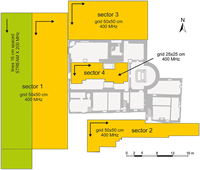GPR versus Geoarchaeological Findings in a Complex Archaeological Site (Badia Pozzeveri, Italy),
Ribolini A., M. Bini, I. Isola, F. Coschino, C. Baroni, M.C. Salvatore, G. Zanchetta and A. Fornaciari (2017).
Archaeological Prospection, 24/2, 141–156, doi:10.1002/arp.1561.
Abstract
The results of a Ground-penetrating radar (GPR) survey were compared with the archaeological excavation outcomes of a twelfth century abbey site (Badia Pozzeveri). The goal was to associate the types of reflections recorded in GPR profiles and high-amplitude features visible in amplitude maps with unearthed archaeological features. GPR profiles crossing the walls evidenced axes of hyperbolic point source reflections and short planar reflections respectively generated by the stones forming the lateral sides/upper corners and the top of the structure. Moreover, the stones in the core of the wall caused small hyperbolic point source reflections with interfering axes, which produced a chaotic reflection profile. The resampling and gridding of these reflections collectively generated high-amplitude linear features in the amplitude maps. The presence in the graves of bones generates small hyperbolic point source reflections with interfering axes in the GPR profile, with a consequently chaotic reflection profile. Moreover, the existence of lythic slabs topping and/or siding the graves generates short planar reflections and axes of hyperbolic point source reflections. The resampling and gridding of these types of reflections generates in the amplitude map features that cannot be locally distinguished from those caused by the local aggregation of sediments with no archaeological relevance. The GPR profiles crossing trenches and pit-kiln showed dipping reflectors unconformably resting on a basal planar reflector. Disconformity marks the onset of trench and pit-kiln decommissioning with the infilling of clayey silty layers and anthropogenic remains. These features in the amplitude maps correspond to medium to high-amplitude areas.
The results show that types of reflection can be associated to specific elements of archaeological structure for a detailed interpretation of a complex subsurface setting. Furthermore, it is evidenced that the interpretation of GPR profiles must be considered an indispensable pre-requisite for a full comprehension of amplitude maps. Copyright © 2016 John Wiley & Sons, Ltd.


